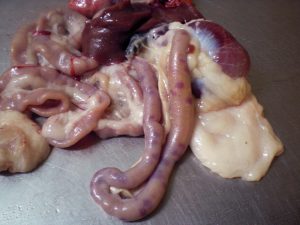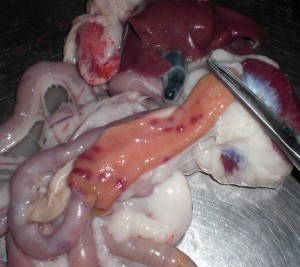22/02/2011
|
Poultry
4
Reddish lesions in the intestine of chicken
This type of images are relatively often seen in poultry farms, but a definitive cause has not been established. Actually those are not considered as lesions, per se, since the possible explanations for such red spots are:
- Changes during euthanasia. When euthanized small arteries may break and form the image of red dots.
- In the literature these red areas have been associated with extramedullary hematopoiesis or areas of congestion.
These lesions have been observed in both healthy and diseased animals. So, not much pathological significance is given to them.




4 comment(s)
Thanks for the photos. In Ukraine we associated that lesions in dead broilers with adenovirus, Clostridium, NDV or coccidia.
In more than 70 % of such cases adenovirus was detected (pcr+histology), more rare – clostridium spp.
I am from egypt and i saw this lesion more in field cases that usually was acompanied by high mortality and i confused between newcastle 7 and clostridia .
so i ask if this sample under went lab diagnosis for both NDV and clostridia
In what type of chicken did u found? is it vaccinate using ND G7 vaccine? to determine the exact diagnose, you have to make sure with the other pathology lession. laboratory HI test can be done to make sure the diagnose
We understand that you suspect that these lesions are caused by Newcastle. In this case the lesions were observed in a broiler. In our region we are free of Newcastle and the broilers (unlike laying and breeding stock) are not vaccinated against this disease. Farms are regularly monitored against NDV because it is a mandatory declaration disease. In addition, usually when we see this lesion, there are no other lesions or signs that make us think of this disease (ND).